
Allocasuarina, commonly known as sheoak or she-oak, is a genus of flowering plants in the family Casuarinaceae and is endemic to Australia. Plants in the genus Allocasuarina are trees or shrubs with soft, pendulous, green branchlets, the leaves reduced to scale-like teeth. Allocasuarinas are either monoecious or dioecious, the flowers never bisexual. Male and female flowers are arranged in spikes, the female spikes developing into cone-like structures enclosing winged seeds.

Casuarina is a genus of flowering plants in the family Casuarinaceae, and is native to Australia, the Indian subcontinent, Southeast Asia, islands of the western Pacific Ocean, and eastern Africa. Plants in the genus Casuarina are monoecious or dioecious trees with green, pendulous, photosynthetic branchlets, the leaves reduced to small scales arranged in whorls around the branchlets, the male and female flowers arranged in separate spikes, the fruit a cone containing grey or yellowish-brown winged seeds.

Allocasuarina humilis, commonly known as the dwarf sheoak or dwarf casuarina, is a woody shrub of the family Casuarinaceae endemic to the south-west of Western Australia.

Allocasuarina distyla, commonly known as scrub she-oak, is a species of flowering plant in the family Casuarinaceae and is endemic to south-eastern New South Wales. It is a dioecious shrub that has branchlets up to 350 mm (14 in) long, the leaves reduced to scales in whorls of six to eight, the fruiting cones 13–35 mm (0.51–1.38 in) long containing winged seeds (samaras) 4.0–8.0 mm (0.16–0.31 in) long.

Allocasuarina decaisneana, commonly known as desert oak, desert sheoak, or kurkara by the Anangu peoples, is a species of flowering plant in the family Casuarinaceae and is endemic to the Central Australia. It is a dioecious tree that typically grows to a height of 10–16 m (33–52 ft) and has long, drooping branchlets, the leaves reduced to scales in whorls of four, the mature fruiting cones 28–95 mm (1.1–3.7 in) long containing winged seeds (samaras) 8.5–17 mm (0.33–0.67 in) long.
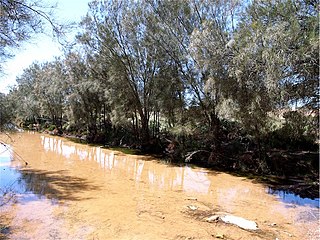
Casuarina obesa, commonly known as swamp she-oak, swamp oak or western swamp oak, or as goolee, kweela, kwerl and quilinock by the Noongar peoples, is a species of flowering plant in the family Casuarinaceae and is endemic to southern continental Australia. It is a dioecious small tree or shrub that forms root suckers, and has drooping or spreading branchlets, the leaves reduced to scales in whorls of 12 to 16, the fruit 10–20 mm (0.39–0.79 in) long containing winged seeds (samaras) 3–5 mm (0.12–0.20 in) long.

Allocasuarina crassa, commonly known as Cape Pillar sheoak, is a species of flowering plant in the family Casuarinaceae and is endemic to a small area in far south-eastern Tasmania. It is a low shrub to small tree that is monoecious or dioecious, with spreading to erect branchlets up to 170 mm (6.7 in) long, the leaves reduced to scales in whorls of seven to ten, the fruiting cones 15–34 mm (0.59–1.34 in) long containing winged seeds (samaras) 5–8 mm (0.20–0.31 in) long.
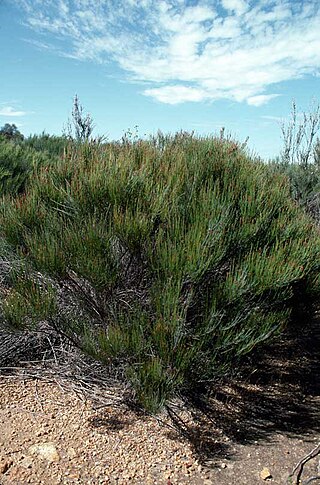
Allocasuarina campestris is a species of flowering plant in the family Casuarinaceae and is endemic to the south-west of Western Australia. It is a dense, monoecious or dioecious shrub that has more or less erect branchlets, the leaves reduced to scales in whorls of seven to nine, the mature fruiting cones 19–42 mm (0.75–1.65 in) long containing winged seeds (samaras) 4.7–10 mm (0.19–0.39 in) long.

Allocasuarina defungens, commonly known as dwarf heath casuarina, is a species of flowering plant in the family Casuarinaceae and is endemic to a restricted area of New South Wales. It is a straggly, dioecious or monoecious shrub that has branchlets up to 120 mm (4.7 in) long, the leaves reduced to scales in whorls of five to seven, the fruiting cones 8–11 mm (0.31–0.43 in) long containing winged seeds (samaras) about 3 mm (0.12 in) long.
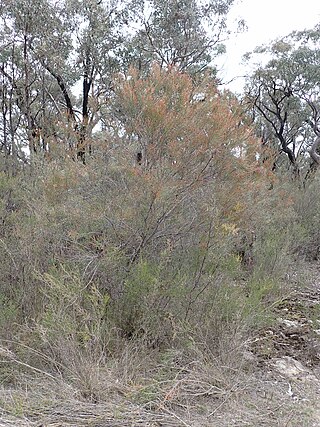
Allocasuarina brachystachya is a species of flowering plant in the family Casuarinaceae and is endemic to the Northern Tablelands of New South Wales. It is an open, usually monoecious shrub that has branchlets up to 70 mm (2.8 in) long, the leaves reduced to scales in whorls of 5 to 7, the fruiting cones 7–14 mm (0.28–0.55 in) long containing winged seeds (samaras) 2.5–4 mm (0.098–0.157 in) long.
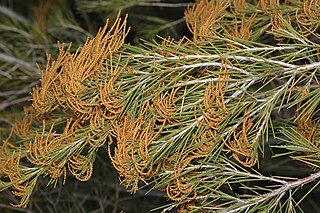
Allocasuarina acuaria is a species of flowering plant in the family Casuarinaceae and is endemic to the southwest of Western Australia. It is a dioecious shrub that has erect branchlets, the leaves reduced to scales in whorls of four on the ends of the branchlets, the fruiting cones 15–19 mm (0.59–0.75 in) long containing winged seeds (samaras) about 6 mm (0.24 in) long.

Allocasuarina acutivalvis is a species of flowering plant in the family Casuarinaceae and is endemic to the southwest of Western Australia. It is a dioecious shrub to small tree that has erect branchlets, the leaves reduced to scales in whorls of 10 to 14, the fruiting cones 15–35 mm (0.59–1.38 in) long containing winged seeds (samaras) 6–12 mm (0.24–0.47 in) long.
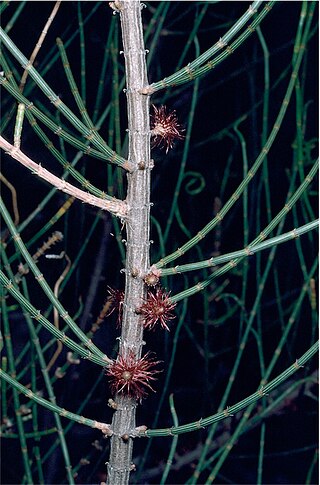
Allocasuarina corniculata is a species of flowering plant in the family Casuarinaceae and is endemic to the south-west of Western Australia. It is an erect to spreading, dioecious shrub that has more or less erect branchlets, the leaves reduced to scales in whorls of six to eleven, the mature fruiting cones 8–15 mm (0.31–0.59 in) long containing winged seeds (samaras) 3–4 mm (0.12–0.16 in) long.

Allocasuarina dielsiana, commonly known as northern sheoak, is a species of flowering plant in the family Casuarinaceae and is endemic to the south-west of Western Australia. It is a dioecious tree that has more or less erect branchlets, the leaves reduced to scales in whorls of six to eight, and the mature fruiting cones 14–30 mm (0.55–1.18 in) long containing winged seeds (samaras) 8–10 mm (0.31–0.39 in) long.

Allocasuarina drummondiana is a species of flowering plant in the family Casuarinaceae and is endemic to the south-west of Western Australia. It is an intricately branched, dioecious shrub that has its leaves reduced to scales in whorls of six or seven, the mature fruiting cones 8–15 mm (0.31–0.59 in) long containing winged seeds (samaras) 3–4 mm (0.12–0.16 in) long.

Allocasuarina eriochlamys is a species of flowering plant in the family Casuarinaceae and is endemic to the south-west of Western Australia. It is a dense, erect, monoecious or dioecious shrub that has more or less erect branchlets, its leaves reduced to scales in whorls of eight to ten, the mature fruiting cones 20–45 mm (0.79–1.77 in) long containing winged seeds (samaras) 5.0–10.5 mm (0.20–0.41 in) long.

Allocasuarina fibrosa, commonly known as woolly sheoak, is a species of flowering plant in the family Casuarinaceae and is endemic to the south-west of Western Australia. It is a dioecious shrub that has branchlets 20–50 mm (0.79–1.97 in) long, the leaves reduced to scales in whorls of four, and the mature fruiting cones 11–25 mm (0.43–0.98 in) long containing winged seeds (samaras) 6–7 mm (0.24–0.28 in) long.
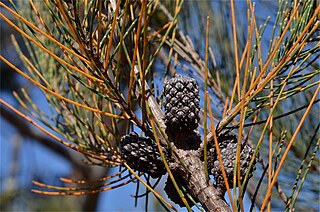
Allocasuarina duncanii, commonly known as Duncan's sheoak, or conical sheoak, is a species of flowering plant in the family Casuarinaceae and is endemic to Tasmania. It is a small dioecious tree that has branchlets up to 200 mm (7.9 in) long, the leaves reduced to scales in whorls of seven to nine, and the fruiting cones 15–60 mm (0.59–2.36 in) long containing winged seeds (samaras) 6–10 mm (0.24–0.39 in) long.
Allocasuarina filidens, commonly known as the Mt Beerwah she-oak, is a species of flowering plant in the family Casuarinaceae and is endemic to a restricted area of Queensland. It is a dioecious shrub that has more or less erect branchlets up to 200 mm (7.9 in) long, the leaves reduced to scales in whorls of five or six, the fruiting cones 14–30 mm (0.55–1.18 in) long containing winged seeds (samaras) 6.5–9 mm (0.26–0.35 in) long.
Allocasuarina anfractuosa, commonly known as sinuous sheoak, is a species of flowering plant in the family Casuarinaceae and is endemic to a restricted area in the southwest of Western Australia. It is a bushy, monoecious shrub that has spreading, sinuous branchlets, the leaves reduced to scales in whorls of 11 to 15, the fruiting cones 28–35 mm (1.1–1.4 in) long containing winged seeds (samaras) 10–12 mm (0.39–0.47 in) long.























